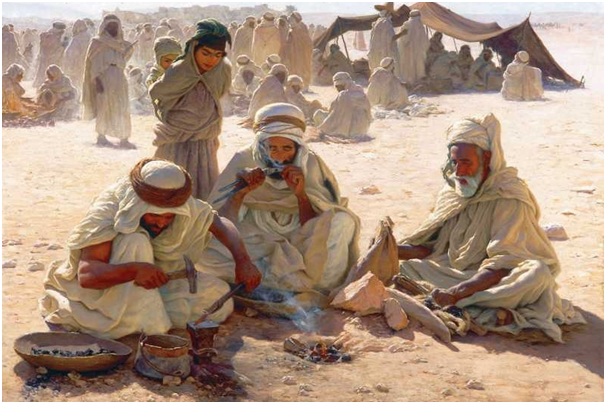The Bedouin In Israel
Bedouin Arabs in South Israel

Once upon a time Negev, southern Israel's semi desert region was the cradle of a colourful Bedouin culture. That is before the birth of the modern State of Israel in 1948.
Here the nomadic way of life dates back to thousands of years. Not too long ago women had played a central role in the economy of the region. They had made tents, tended to the sheep and goats, raised crops and cared for the children. But without land and no possibility to earn a living from agriculture and herding has increased the dependence of women on men.
According to Ibrahim al-Waqili, head of the Bir al-Meshash and deputy chairman of the Regional Council of Unrecognised Villages in the Negev, the Israeli authorities first pushed the Bedouin into reserves. In 1966, the sheep of the Bedouin were allowed to wander on natural pastures once more but a Green Patrol set up in 1977 put an end to that freedom. The Black Goat Law was enforced, most of the Bedouin flocks were confiscated and sold by the State.
This is despite the fact that the Bedouin have lived on this land under both Ottoman and British rule, paying taxes to the changing regimes and minding their own business. In 1948 many of them were evacuated beyond the borders of the new country of Israel, agricultural land was sprayed with poisonous materials and homes were bulldozed.
Pastures on which sheep had grazed for eons have now been taken away by the government, nationalised and leased every year by the Agricultural Ministry at a fee to owners. There is no way that a Bedouin can have his own farm with grazing land like Jewish farmers.
In several years this may not even matter as the Bedouin tradition of herding sheep is forgotten for forever. Then only Jewish people will be left to tend to flocks in the Negev.
Al-Waqili's story is documented by Israeli 'activist' artist Tad Adler who also lives and works in Vienna, Austria. His work is part of an impressive group exhibition called Fascination Photography at the Essl Museum of Contemporary Art where the artistic use of the camera is encouraged to focus on ideas of cultural identity and the social surroundings of those represented.
Adler's contribution to the same exhibition is the Unrecognised Villages project which is a work in progress and began in 2003 following reports that Bedouin fields in the Negev were sprayed with a toxic substance from the air, in a State-sponsored act.
Adler looked into the matter and was inspired to bring the story of the Bedouin villages to the attention of wider audiences in Israeli society and abroad. His project about a weakened and discriminated community disregarded by the state’s policy began with an appeal to individuals, to officials and to groups from the unrecognized villages to help him portray each village through a story and a photograph. The decision on the story to be told and the photograph to accompany it was made jointly and included meetings, interviews and joint discussions.
This is because most of Adler's artistic work is inspired by society, economy and the politics of daily life. His panoramic photographs are quite opposite to the romantic perception of his country's leadership of the Negev and its inhabitants viewed as a flock of sheep and a shepherd playing the flute on the horizon. This idea is challenged with images of a contemporary and rich reality.
The purpose of Adler's project is to raise awareness and to inspire change. An earlier project is his OneState involving the Palestine artist Osama Zatar. Together Adler and Zatar declare that they are ambassadors of the OneState embassy in Vienna. The symbolic OneState country advocates the idea of open borders and the coexistence of different cultures.
In all his work Adler highlights values of equality and freedom and tranquil coexistence. He is opposed to the politics of intolerance of other nations and other people of different ethnic groups.
In a letter he wrote in 2008 to the then Israeli Ambassador in Vienna and which is part of a catalogue of one of his exhibitions, Adler says that with time he has developed a more complex understanding of Israel’s political reality and the urgent need for social change.
That he is part of a community composed of individuals and groups from a variety of backgrounds and professions, in Israel and abroad. Common to all is the understanding of the urgent need for social change...Members of this community use their profession, skills and resources to promote values of equality, human and civil rights, social justice, environmental protection, resistance to the occupation and discrimination, solidarity, democracy… And so one finds lawyers, filmmakers, lecturers, students, researchers, physicians and therapists, journalists, social workers, designers and artists – all devoting their capabilities to making the change.
To the ambassador's suggestion to exhibit his work only in Israel, Adler says no!
For a project like his, he hopes can serve as an example within, and outside Israel. It can get everyone, even the international audience to remove the mask of ignorance, of fear and of false perceptions to look inward, at its own communities, at its own hidden stories of racism, discrimination, disregard, and entrenchment in self-righteousness.



